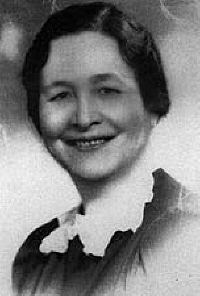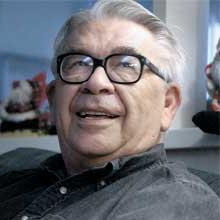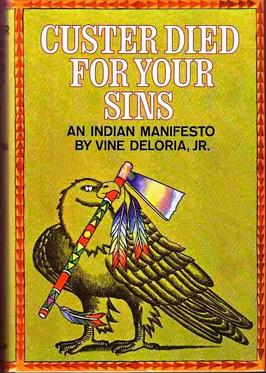
Among the Haudenosaunee the Great Law of Peace, also known as Gayanashagowa, is the oral constitution of the Iroquois Confederacy. The law was written on wampum belts, conceived by Dekanawidah, known as the Great Peacemaker, and his spokesman Hiawatha. The original five member nations ratified this constitution near modern-day Victor, New York, with the sixth nation being added in 1722.

The Onondaga people are one of the five original nations of the Haudenosaunee (Iroquois) Confederacy in the Northeastern Woodlands. Their historical homelands are in and around present-day Onondaga County, New York, south of Lake Ontario.

Ella Cara Deloria, also called Aŋpétu Wašté Wiŋ, was a Yankton Dakota (Sioux) educator, anthropologist, ethnographer, linguist, and novelist. She recorded Native American oral history and contributed to the study of Native American languages. According to Cotera (2008), Deloria was "a pre-eminent expert on Dakota/Lakota/Nakota cultural religious, and linguistic practices." In the 1940s, Deloria wrote a novel titled Waterlily, which was published in 1988, and republished in 2009.

Vine Victor Deloria Jr. was an author, theologian, historian, and activist for Native American rights. He was widely known for his book Custer Died for Your Sins: An Indian Manifesto (1969), which helped attract national attention to Native American issues in the same year as the Alcatraz-Red Power Movement. From 1964 to 1967, he served as executive director of the National Congress of American Indians, increasing its membership of tribes from 19 to 156. Beginning in 1977, he was a board member of the National Museum of the American Indian, which now has buildings in both New York City and in Washington, DC, on the Mall.
There are four treaties of Buffalo Creek, named for the Buffalo River in New York. The Second Treaty of Buffalo Creek, also known as the Treaty with the New York Indians, 1838, was signed on January 15, 1838 between the Seneca Nation, Mohawk nation, Cayuga nation, Oneida Indian Nation, Onondaga (tribe), Tuscarora (tribe) and the United States. It covered land sales of tribal reservations under the U.S. Indian Removal program, by which they planned to move most eastern tribes to Kansas Territory west of the Mississippi River.
The Great Peacemaker, sometimes referred to as Deganawida or Tekanawí:ta was by tradition, along with Jigonhsasee and Hiawatha, the founder of the Haudenosaunee, commonly called the Iroquois Confederacy. This is a political and cultural union of six Iroquoian-speaking Native American tribes residing in the present-day state of New York, northern Pennsylvania, and the eastern portion of the province of Ontario, Canada.
Native American studies is an interdisciplinary academic field that examines the history, culture, politics, issues, spirituality, sociology and contemporary experience of Native peoples in North America, or, taking a hemispheric approach, the Americas. Increasingly, debate has focused on the differences rather than the similarities between other Ethnic studies disciplines such as African American studies, Asian American Studies, and Latino/a Studies.
Oren R. Lyons Jr. is a Native American Faithkeeper of the Turtle Clan. The Seneca are one of the Six Nations of the historic Haudenosaunee Confederacy. For more than 14 years he has been a member of the Indigenous Peoples of the Human Rights Commission of the United Nations, and has had other leadership roles.

Charlene Teters is a Native American artist, educator, and lecturer. Her paintings and art installations have been featured in over 21 major exhibitions, commissions, and collections. She is a member of the Spokane Tribe, and her Spokane name is Slum Tah. She was born and raised in Spokane, Washington, near the Spokane Indian Reservation.
Joseph Bruchac is an American writer and storyteller based in New York.

Bobby Bridger is a singer/songwriter/poet/actor/playwright/author and painter who for five decades has traveled the globe performing a trilogy of one man shows for audiences in America, Canada, Europe, Australia and Russia. He has recorded numerous albums for labels including Monument Records, RCA and Golden Egg Records. On television he appeared twice on the early years of PBS's "Austin City Limits", on American Experience on PBS, and on ABC's "Good Morning America", A & E and C-SPAN, as well as on NPR on radio. He is the composer of "Heal In The Wisdom", the official anthem of the Kerrville Folk Festival for over 40 years. In April, 1988 Bridger sang "Heal in the Wisdom" to close the first "GlobalForum of Spiritual and Parliamentary Leaders on Human Survival" at Christ Church, Oxford, England.
Philip Joseph Deloria is a historian, author and member of the Dakota Nation who specializes in Native American, Western American, and environmental history. He is the son of scholar Vine Deloria, Jr., and the great nephew of ethnologist Ella Deloria. Deloria is the author of the award-winning books Playing Indian (1998) and Indians in Unexpected Places (2004), among others. Deloria received his Ph.D. in American Studies from Yale University and currently teaches in the Department of History at Harvard University. In 2021 he was elected to the American Philosophical Society.
Spencer Asah was a Kiowa painter and a member of the Kiowa Six from Oklahoma.

Custer Died for Your Sins: An Indian Manifesto is a 1969 non-fiction book by the lawyer, professor and writer Vine Deloria, Jr. The book was noteworthy for its relevance to the Alcatraz-Red Power Movement and other activist organizations, such as the American Indian Movement, which was beginning to expand. Deloria's book encouraged better use of federal funds aimed at helping Native Americans. Vine Deloria, Jr. presents Native Americans in a humorous light, devoting an entire chapter to Native American humor. Custer Died for Your Sins was significant in its presentation of Native Americans as a people who were able to retain their tribal society and morality, while existing in the modern world.
Philip Levy is an American historian and archaeologist. He received his Ph.D. in American History from William and Mary in 2001. He, along with David Muraca, is a co-leader of the excavation of Ferry Farm, the site of George Washington's childhood home. Levy and Muraca are credited with finding the foundations of the house where Washington was raised. He is an associate professor at the University of South Florida. His fields of research are Early America, Virginia History, Place and Landscape, Historical Archaeology, and Public History.

Agents of Repression: The FBI's Secret Wars Against the Black Panther Party and the American Indian Movement is a book by Americans Ward Churchill and Jim Vander Wall, first published in 1988. It describes government campaigns to disrupt the legal political activities of the Black Panther Party and the American Indian Movement, especially through actions of the FBI.
This study gives a chilling account of the government attack against the American Indian Movement and the Black Panther Party, placed in the context of the traditional use of the FBI for domestic political repression. It is a powerful indictment, with far–reaching implications concerning the treatment of political activists, especially those that are Black or Native American, and the functioning of our political institutions generally.

The Great Sioux Nation: Sitting in Judgment on America is a book edited by Roxanne Dunbar-Ortiz, "An Oral History of the Sioux Nation and Its Struggle for Sovereignty", that documents the 1974 "Lincoln Treaty Hearing". Testimony produced during that hearing has been cited by the International Indian Treaty Council in advocating for Indigenous sovereignty and treaty rights, efforts which eventually saw the 2007 Declaration on the Rights of Indigenous Peoples.
Bruce Elliott Johansen is an American academic and author. He is the Frederick W. Kayser Professor of Communication at the University of Nebraska at Omaha and is the author or editor of many books and articles, notably on environmental and Native American issues.
Inés M. Talamantez was an ethnographer and scholar of religion. She was professor of religious studies at University of California, Santa Barbara (UCSB). She was an expert on Native American religion and philosophy.

Maris Bryant Pierce, was a Seneca Nation chief, lawyer, and teacher. He was a tribal land-rights activist, and a major influence to the Second Treaty of Buffalo Creek of 1838.









